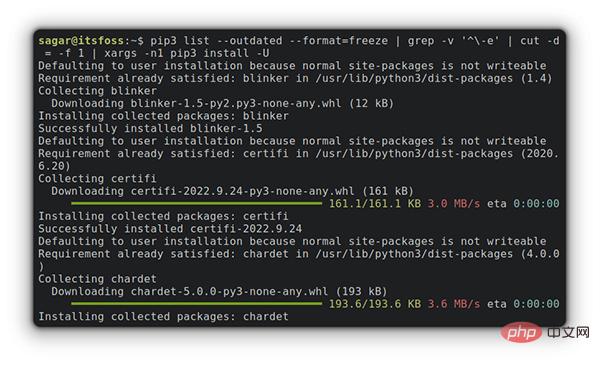Home >Backend Development >Python Tutorial >Upgrading Python packages using Pip
Upgrading Python packages using Pip
- PHPzforward
- 2023-04-13 19:07:083973browse

When was the last time you updated a Python package installed via Pip? Most users tend to forget that these Python packages also need to be updated manually since just updating the system repository does not work for the packages.
So let’s take a moment to look at how to use Pip to update older Python packages.
How to use Pip to upgrade Python software packages
Pip (Pip Installs Packages) is a command line utility for managing Python software packages command line utility. You can use Pip to install Python packages, similar to how you use apt to manage packages in Ubuntu and Debian.
So, let’s take a closer look at how to use this awesome tool Pip to manage content related to Python packages.
1. List outdated Python software packages
Before planning to update any software packages, we must first list the outdated software packages, and you can choose the ones you want to update. packages, since most people won't want to update their entire package repository at once.
To list obsolete Python packages, you just need to combine the pip command with the list option, The --outdated flag can be used together, as shown below:
pip list --outdated

##outdated packages
2 , Upgrade specific software packagesAfter obtaining the list of updateable software packages, you can select the specific software package you want to update as I mentioned before. The syntax of the pip upgrade package command is as follows :pip install package_name -UFor example, I want to upgrade the package named
anime-api to the latest version, so I will use the following command to upgrade:
pip install anime-api -U

update anime api
3. Upgrade the software package to a specific versionIt is not necessary to always use software The latest version. If you want to upgrade the package to a specific version that is not the latest, refer to the following command syntax:pip install --upgrade <package>==<version>For example, I want to upgrade the package named
xdg The software package is updated to version 5.1, which is the previous version of the latest version, so you can use the following command:
pip install --upgrade xdg==5.1

4. Use Pip to upgrade all packages at once
Please note: I do not recommend that you upgrade all packages at once, because the dependencies of Python packages are too complex. , a one-time upgrade cannot handle interdependencies.To upgrade all python packages at once, you can use the following command:
pip3 list --outdated --format=freeze | grep -v '^-e' | cut -d = -f 1 | xargs -n1 pip3 install -U

The above command uses
xargs. First, you will get all the software packages that need to be updated, and then execute the pip3 install -U command for each software package. <p>I am using <code style="background-color: rgb(231, 243, 237); padding: 0px 3px; border-radius: 4px; overflow-wrap: break-word; text-indent: 0px;">pip3 here instead of pip. In Ubuntu 22.04 and higher, both the pip and pip3 commands can be used.
Summary
Using Pip to update all Python packages at once is not a good idea. I found that after a one-time update, dependencies between packages were broken, so make sure to only update the packages you want to update.
The above is the detailed content of Upgrading Python packages using Pip. For more information, please follow other related articles on the PHP Chinese website!

